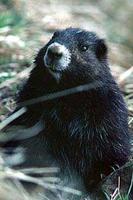Endangered Species
ENDANGERED SPECIES are species of plants, animals and plant communities considered to be in imminent danger of extinction or extirpation in BC. BC has no endangered species act, but there are some existing laws that could legally protect some species: the Wildlife Act, the ECOLOGICAL RESERVES Act, the Fish Protection Act and the Forest Practices Code Act. Only once in the past 20 years has BC's Wildlife Act been used to designate critical habitat for an animal species (the Vancouver Island MARMOT); less than 20% of endangered species in the province are protected by PARKS and protected areas.
There is also no specific legislation at the federal level, although an endangered species act for Canada was introduced in Parliament early in 2001. A national body, the Committee on the Status of Endangered Wildlife in Canada (COSEWIC), was established in 1977 to determine the status of species suspected of being at risk. As of 2001, COSEWIC listed 387 species at risk throughout the country (112 in BC). Another national initiative is RENEW (committee on the Recovery of Naturally Endangered Wildlife), established in 1988 by provincial wildlife ministers from across the country to work for the protection and recovery of endangered species.
Species become endangered because growing human populations are putting ever greater demands on natural resources and the environment; specifically, a number of human activities cause significant changes to ecosystems and direct loss of habitats. These include road building and other forms of access and disturbance; LOGGING, MINING, urban, recreational and HYDROELECTRIC developments; grazing and AGRICULTURE; the introduction of exotic or alien species that displace native species (see KNAPWEED, for example); poaching; human-caused fires; widespread air and water pollution; and CLIMATE change. Provincial wildlife authorities consider access and loss of habitat to be the 2 most important factors in the decline of wildlife populations.
While only 4 animal species in BC are listed as endangered under the Wildlife Act—burrowing OWL, Vancouver Island marmot, white PELICAN and SEA OTTER—the province's Conservation Data Centre has devised a system of keeping track of endangered species: plants, plant associations and animals considered to be at risk are placed on the Red and Blue lists. Species (and plant associations) on the Red List are considered candidates for endangered or threatened status. These species occur in low abundance and are threatened with imminent extinction or extirpation throughout all or a significant portion of their range in BC. Threatened species are any indigenous species likely to become endangered if factors affecting their vulnerability are not reversed. The Blue List denotes species at risk and sensitive or vulnerable species. Indigenous species are placed on the Blue List when their populations are low or declining, when they occur at the fringe of their range (because some factor has driven them from their optimum range), or when they occur in restricted areas (areas that serve to enclose or isolate populations and prevent natural movements of genes and species). Population viability is a major concern for Blue-listed species because there is a downward trend in their population, or a downward trend in available or suitable habitat, or both. This category also includes species that are generally suspected of being vulnerable but about which there is not enough information to allow designation in another category.
In BC, 208 vertebrate species are Red- and Blue-listed, including ermine, wood bison, BADGER, all 4 populations of white STURGEON, bull TROUT, northern leopard FROG, Pacific giant SALAMANDER, western GREBE, upland SANDPIPER, Ferruginous HAWK, marbled MURRELET, northern spotted owl, purple martin, trumpeter SWAN, mountain CARIBOU, Roosevelt ELK, grizzly BEAR and 2 subspecies of WOLVERINE.
Native vascular plants on the lists number 595 species, 30% of the total vascular plants in the province, including yellow montane violet, pink sand verbena, southern maidenhair fern, riverbank anemone, deltoid balsamroot, 3 species of evening primrose, giant helleborine and wild licorice.
In addition to individual species, plant associations may also be Red- and Blue-listed. A plant association, analogous to a species, is a unit of vegetation with a relatively uniform species composition and physical structure, tending to have characteristic environmental features. These associations provide habitat for many rare plants and animals; most important, they perform functions that influence their environment and set the stage for complex interactions between organisms. Losing plant associations not only harms the species that depend on them, it also has far-reaching effects that are not fully understood. In 1999 there were 241 Red- and Blue-listed plant associations, including these on the Red-list: DOUGLAS FIR/SALAL, Douglas fir/Garry OAK–oniongrass, Douglas fir/ARBUTUS, ponderosa PINE/black cottonwood–Nootka rose–poison ivy, water birch–red osier DOGWOOD, ponderosa pine/black cottonwood–snowberry, and certain GRASSLAND plant associations such as bluebunch wheatgrass–junegrass.
by Maggie Paquet

